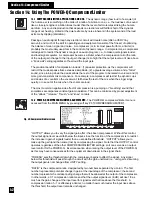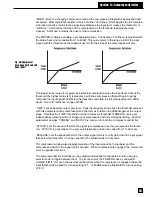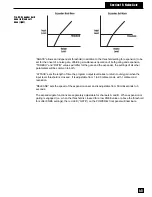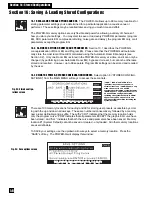
“FBX FILTER TRACKING” globally adjusts the range over which an automatic FBX filter can move
to accommodate feedback frequencies that may drift slightly as a result of humidity and tempera-
ture changes (see section 11.2). This parameter is adjustable to a width from .01 to .10 octave,
centered around the original frequency of the automatic FBX filter. If feedback occurs within your
specified window, the POWER-Q automatically “tracks” it with the existing filter.
“FBX FILTER PERSISTENCE” determines the relative length of time that a suspected feedback
tone or signal must be present before it is classified as feedback and automatically suppressed.
PERSISTENCE is used in conjunction with SENSITIVITY to determine the authenticity of feed-
back and to discriminate musical tones from real feedback. Higher values of PERSISTENCE
require more time for the POWER-Q to decide whether a given signal is feedback. For musical
styles that may feature long sustained notes or tones (e.g., classical), set the PERSISTENCE
value high (4 or 5, for example) to minimize the chance of mistaking the long sustain for real
feedback. Set PERSISTENCE to 2 for speech applications. Range of values: 1-5. Default: 3
“FBX FILTER SENSITIVITY” adjusts the POWER-Q’s sensitivity to the harmonic content of the
suspected feedback signal before it can be classified as feedback. Used in conjunction with
PERSISTENCE, SENSITIVITY discriminates between feedback, which tends to have low har-
monic content, and music tones, which tend to have more harmonic content. Some musical
instruments and singers are capable of producing tones which have very low harmonic content
and can be easily mistaken for feedback by the POWER-Q. Higher values of SENSITIVITY will
allow feedback to grow larger in magnitude before it is detected and eliminated; too low a value
can result in mistaking certain musical tones for feedback. Use the DEFAULT setting of 5 for
most venues; use the value 2 for more classical venues and 4 for spoken word applications.
Range of values: 0 -10. Default: 5
For ultra fast feedback detection during setup, set PERSISTENCE and SENSITIVITY to their
lowest values. For performance, experiment until you find the best setting for your application.
“REF MIC PHANTOM POWER” makes +48v available at the reference microphone input for
microphones that require phantom power.
“REF MIC 20dB PAD” lowers the gain (by 20 dB) of the reference microphone preamp in the event
that the signal coming from the microphone is clipping the input level. NOTE: DO NOT use a
microphone preamp or balanced line transformer with this input. This may cause the reference
mic board to overheat.
COPY FUNCTION.
The third soft key in the Global Parameters screen allows you to select a "COPY"
option with the up/down arrow keys and implement it by pressing ENTER. You may:
1. Copy parameters from A to B. This option will instantaneously copy all parameters currently
set for channel A to channel B. Any further adjustments made to either channel will be
independent until COPY is executed again.
2. Copy parameters from B to A. This option will instantaneously copy all parameters cur-
rently set for channel B to channel A. Any further adjustments made to either channel will
be independent until COPY is executed again.
Canceling the COPY function will allow the POWER-Q to operate as an independent, two channel,
"dual mono" unit.
49
Section 17: Global Parameters
Fig. 58: COPY options screen
















































